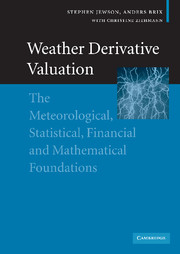 Weather Derivative Valuation
Weather Derivative Valuation Book contents
- Frontmatter
- Contents
- List of figures
- List of tables
- Acknowledgements
- 1 Weather derivatives and the weather derivatives market
- 2 Data cleaning and trends
- 3 The valuation of single contracts using burn analysis
- 4 The valuation of single contracts using index modelling
- 5 Further topics in the valuation of single contracts
- 6 The valuation of single contracts using daily modelling
- 7 Modelling portfolios
- 8 Managing portfolios
- 9 An introduction to meteorological forecasts
- 10 The use of meteorological forecasts in pricing
- 11 Arbitrage pricing models
- 12 Risk management
- 13 Modelling non-temperature data
- A Trend models
- B Parameter estimation
- C Goodness of fit tests
- D Expected pay-offs for normally distributed indices
- E Pay-off variances for normally distributed indices
- F Greeks for normally distributed indices
- G Exact solutions for the kernel density
- H The beta for a normally distributed index
- I Simulation methods
- J Efficient methods for pricing against a portfolio
- References
- Index
6 - The valuation of single contracts using daily modelling
Published online by Cambridge University Press: 22 September 2009
- Frontmatter
- Contents
- List of figures
- List of tables
- Acknowledgements
- 1 Weather derivatives and the weather derivatives market
- 2 Data cleaning and trends
- 3 The valuation of single contracts using burn analysis
- 4 The valuation of single contracts using index modelling
- 5 Further topics in the valuation of single contracts
- 6 The valuation of single contracts using daily modelling
- 7 Modelling portfolios
- 8 Managing portfolios
- 9 An introduction to meteorological forecasts
- 10 The use of meteorological forecasts in pricing
- 11 Arbitrage pricing models
- 12 Risk management
- 13 Modelling non-temperature data
- A Trend models
- B Parameter estimation
- C Goodness of fit tests
- D Expected pay-offs for normally distributed indices
- E Pay-off variances for normally distributed indices
- F Greeks for normally distributed indices
- G Exact solutions for the kernel density
- H The beta for a normally distributed index
- I Simulation methods
- J Efficient methods for pricing against a portfolio
- References
- Index
Summary
In chapter 4 we considered methods for the pricing of temperature-based weather derivatives that involve statistical modelling of the historical values of the contract settlement index. In this chapter we investigate methods that involve statistical modelling of the underlying temperature. Since the temperature measurements used for most weather contracts are daily values we will focus on the modelling of daily temperatures.
Using models of daily temperature to price weather derivatives has a number of advantages and disadvantages relative to using models of the contract settlement index.
The potential advantages include:
more complete use of the available historical data;
more accurate representation of the index distribution;
more accurate extrapolation of extremes;
more accurate mark to model estimates during the contract;
consistent use of one model for all contracts on one location;
easier incorporation of meteorological forecasts into the pricing algorithm.
The main disadvantage of using daily models is the added complexity; as we will see, daily models are significantly more complex than the index modelling methods of chapter 4. This, in turn, leads to greater risk of model error.
In practice, because of this disadvantage, daily models are currently used much less frequently than index models. However, as more research is done into these models their use is likely to increase.
The advantages of daily modelling
We now describe in more detail the advantages of using daily temperature modelling methods.
Information
- Type
- Chapter
- Information
- Weather Derivative ValuationThe Meteorological, Statistical, Financial and Mathematical Foundations, pp. 121 - 147Publisher: Cambridge University PressPrint publication year: 2005